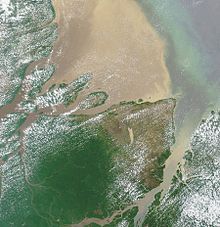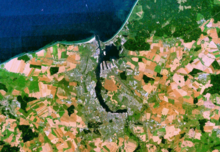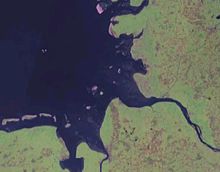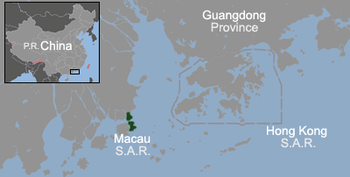Estuary
![]()
This article is about a form of estuary. For a Gabonese province, see Estuaire.
An estuary (Latin aestuarium "river mouth exposed to the tide" or "bay") is the broad body of water at the mouth of a river or stream on a usually shallow subsidence coast.
According to the Leeuwarden Declaration, the landward boundaries of the estuaries in the German Bight are defined as the average boundary from brackish to fresh water and the seaward boundaries as the average location of the 10 PSU isohaline.
Typical funnel-shaped estuaries such as the Lower Elbe are found on tidal coasts. But also the estuarine lagoons found on subsidence coasts without a strong tidal range are called estuaries, for example the Lower Warnow. On the other hand, deltas predominate on uplift coasts and/or where there is a large bedload, even with a strong tidal range, as on the Ganges-Brahmaputra delta. Tidal deltas may consist of estuaries, such as the Amazon delta and the part of the Rhine-Meuse-Scheldt delta located in the Dutch province of Zeeland.
In the EU Water Framework Directive, the additional category of transitional waters was created for estuaries in addition to flowing waters, standing waters and coastal waters. Its application is still under development. In Annex I of the Habitats Directive, estuaries are also listed as a habitat type to be protected.
More recently, the term estuary has also been applied to those river mouths that do not meet all the definitional conditions: For example, the Ems estuary is not funnel-shaped, Lower Warnow and Lower Trave are not tidal, and Inner and Outer Jade are not strictly speaking the lower reaches of the River Jade because of their high salinity.

The northern Amazon estuary (image from NASA's Terra satellite)
Origin and characteristics
Funnel-shaped estuaries
Typical estuaries are formed under the influence of tidal currents, whereby the river mouth is widened in a funnel shape (funnel estuary): In these tidally influenced transition zones between marine and fluvial areas, the tides cause a pendulum motion of often greater volume than the seaward discharge of the river water. The high flow velocities associated with the pendulum motion ensure that erosion is greater than sedimentation. The heavy salt water advances wedge-shaped into the river from the sea at high tide and is overlain by the fresh water of the river. In the process, the strong tidal flow erodes the riverbed and banks, and much material is transported upstream.
This material cannot be removed by the usually weaker ebb current. For this reason, delta formation can occur at the upper end of estuaries. A remnant of such a delta is the branching of the Elbe into the Norderelbe and Süderelbe in Hamburg. Shipping has used estuaries as natural harbours for centuries. Here, ships were protected from storms and pirates. Before motorisation, vessels were driven by the tidal current to the harbour towns, which were usually founded at the inner end of the funnel and, being located in the middle of the country, had a large catchment area. Although not quite as confusing as deltas, estuaries also mostly require pilots.
Due to the Coriolis force, seawater is deflected clockwise in the northern hemisphere and counterclockwise in the southern hemisphere. Depending on the geographical conditions, the riverbanks can be affected differently by erosion and sedimentation.
In the Amazon, the flood flow can be traced up to about 870 km from the coast.
| Characteristics of four German estuaries flowing into the German Bight | ||||
| Eider | Elbe | Weser | Ems | |
| Catchment area above the dam [10³-km²]. | 02 | 135 | 038 | 013 |
| Mean water discharge rate [m³/s] | 23 | 725 | 323 | 125 |
| Mean tidal range in the area of the weir [m]. | 02 | 002,4 | 004,1 | 002,8 |
| Length of inner estuary [km] | 21 | 120 | 070 | 050 |
Lagoon estuaries
On coasts without a significant tidal range, the current acceleration caused by the tides is missing. The defining feature "exposed to the tide" is therefore missing. Here, the slowing of the current dominates at river mouths. Dunes on the coast form an additional flow obstacle. On uplift coasts, sedimentation in the accumulation area leads to rapid siltation and thus to delta formation. On subsidence coasts, sedimentation is compensated for by the continuous rise in sea level, especially in rivers with a low bedload. This results in microtidal estuaries, not funnel-shaped but lagoon-shaped, such as the Lower Warnow and the Szczecin Lagoon at the mouth of the Oder. Bays formed during the ice age can also become estuaries, such as Traveförde in the Trave estuary.
Water quality
Estuaries, like deltas, are characterized by the transition of freshwater to saltwater (brackish water), a material load resulting from the movement of water. This depends on the flow velocity of the outflowing freshwater of the river in relation to the tide and the amount of saltwater flowing up with it. The tide in turn depends on the position of the moon (see spring tide, neap tide) and the respective weather conditions (possible storm surge) and thus also results in a very individual change of flora and fauna from the river area to the sea due to the resulting average water temperature.

The Lower Warnow

Funnel-shaped mouths of the Jade (centre left), Weser (below centre), Elbe (right of centre) and Eider (above) into the German Bight (North Sea)
Rivers with estuaries
Estuary funnel
America
- Amazon - its northern estuary combined with a forming underwater delta
- Hudson
- Río de la Plata - common estuary of Paraná and Uruguay
- Saint Lawrence Current
Africa
- Gambia
- Congo
- Senegal
Asia
- Yenisei
- Whether
- Pearl River - common estuary of the West, East and North Rivers
Australia
The southeastern Australian state of New South Wales has more than 170 estuaries along more than 1100 kilometers of coastline. Since 2006, the state has been comprehensively measuring the water temperature in 1 m water depth. This shows that the brackish water is warming at an above-average rate in the wake of man-made global warming: by almost 2.2 ° in less than 12 years.
Europe
Germany
- Eider - further natural development now restricted by the Eider barrage
- Elbe
- Ems
- Eastern
- Weser
France
- Gironde - common estuary of Garonne and Dordogne
- Loire
- Its
Ireland
- Shannon
Netherlands
- Scheldt
Portugal
- Tagus
United Kingdom
- Loughor
- Mersey
- Thames
- Conwy
Estuarine Lagoon
- Jeja
- Cameroon Estuary
- Cuban
- Oder / Szczecin Lagoon
- Trave
- Warnow
Transitional forms
- Dnepr

Macau and Hong Kong, in between the Pearl River Estuary
Search within the encyclopedia